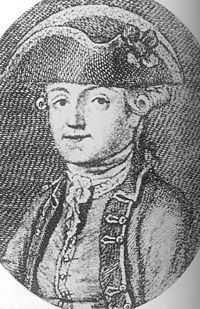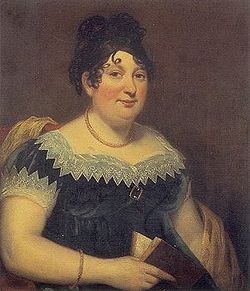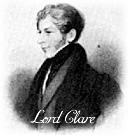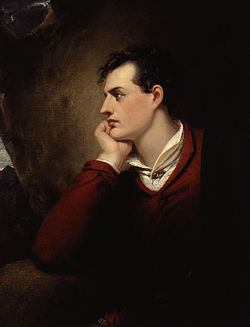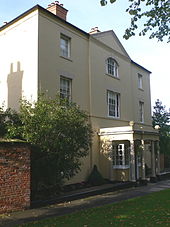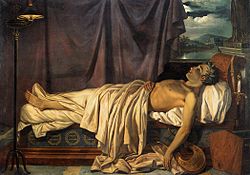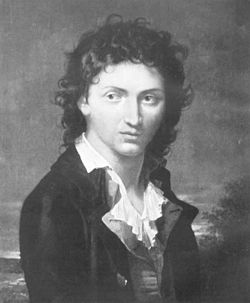
Lord Byron
Background to the schools Wikipedia
Arranging a Wikipedia selection for schools in the developing world without internet was an initiative by SOS Children. With SOS Children you can choose to sponsor children in over a hundred countries
| The Right Honourable The Lord Byron FRS |
|
|---|---|
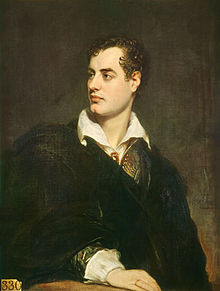 |
|
| Byron in 1824 | |
| 6th Baron Byron | |
| In office 19 May 1798 – 19 April 1824 |
|
| Succeeded by | George Byron |
| Personal details | |
| Born | George Gordon Byron 22 January 1788 London, England, Great Britain |
| Died | 19 April 1824 (aged 36) Missolonghi, Aetolia-Acarnania, Ottoman Empire |
| Nationality | British |
| Spouse(s) | Anne Isabella Byron, Baroness Byron |
| Domestic partner | Claire Clairmont |
| Children | Ada Lovelace Allegra Byron |
| Occupation | Poet, politician |
| Signature | |
George Gordon Byron, 6th Baron Byron, later George Gordon Noel, 6th Baron Byron, FRS (22 January 1788 – 19 April 1824), commonly known simply as Lord Byron, was an English poet and a leading figure in the Romantic movement. Among Byron's best-known works are the lengthy narrative poems Don Juan and Childe Harold's Pilgrimage and the short lyric " She Walks in Beauty." He is regarded as one of the greatest British poets and remains widely read and influential.
He travelled to fight against the Ottoman Empire in the Greek War of Independence, for which Greeks revere him as a national hero. He died at age 36 from a fever contracted while in Missolonghi in Greece.
Byron was celebrated in life for aristocratic excesses, including huge debts, numerous love affairs, rumours of a scandalous incestuous liaison with his half-sister, and self-imposed exile. It has been speculated that he suffered from bipolar I disorder.
Name
Byron's names were changed throughout his life. He was the son of Captain John "Mad Jack" Byron and his second wife, the former Catherine Gordon (d. 1811), a descendant of Cardinal Beaton and heiress of the Gight estate in Aberdeenshire, Scotland. Byron's father had previously seduced the married Marchioness of Caermarthen and, after she divorced her husband, he married her. His treatment of her was described as "brutal and vicious", and she died after having given birth to two daughters, only one of whom survived: Byron's half-sister, Augusta.
Byron's paternal grandparents were Vice-Admiral the Hon. John "Foulweather Jack" Byron and Sophia Trevanion.
Vice Admiral John Byron had circumnavigated the globe, and was the younger brother of the 5th Baron Byron, known as "the Wicked Lord".
He was christened, at St Marylebone Parish Church, "George Gordon Byron" after his maternal grandfather George Gordon of Gight, a descendant of James I of Scotland, who had committed suicide in 1779.
In order to claim his second wife's estate in Scotland, Byron's father took the additional surname "Gordon", becoming "John Byron Gordon", and he was occasionally styled "John Byron Gordon of Gight". Byron himself used this surname for a time and was registered at school in Aberdeen as "George Byron Gordon". At the age of 10, he inherited the English Barony of Byron of Rochdale, becoming "Lord Byron", and eventually dropped the double surname (though after this point his surname was secondary to his peerage).
In 1822 when Byron's mother-in-law Judith Noel died, her will required that he change his surname to "Noel" in order for him to inherit half of her estate. He obtained a Royal Warrant allowing him to "take and use the surname of Noel only". The Royal Warrant also allowed him to "subscribe the said surname of Noel before all titles of honour", and from that point he signed himself "Noel Byron" (the usual signature of a peer being merely the peerage, in this case simply "Byron"). It is speculated that this was so that his initials would read "N.B.", mimicking those of his hero, Napoleon Bonaparte. He was also sometimes referred to as "Lord Noel Byron", as if "Noel" were part of his title, and likewise his wife was sometimes called "Lady Noel Byron". Lady Byron eventually succeeded to the Barony of Wentworth, becoming "Lady Wentworth".
Early life
John Byron married his second wife for the same reason that he married his first: her fortune. Byron's mother had to sell her land and title to pay her new husband's debts, and in the space of two years the large estate, worth some £23,500, had been squandered, leaving the former heiress with an annual income in trust of only £150. In a move to avoid his creditors, Catherine accompanied her profligate husband to France in 1786, but returned to England at the end of 1787 in order to give birth to her son on English soil. He was born on 22 January in lodgings at Holles Street in London.
Catherine moved back to Aberdeenshire in 1790, where Byron spent his childhood. His father soon joined them in their lodgings in Queen Street, but the couple quickly separated. Catherine regularly experienced mood swings and bouts of melancholy, which could be partly explained by her husband's continuing to borrow money from her. As a result, she fell even further into debt to support his demands. It was one of these importunate loans that allowed him to travel to Valenciennes, France, where he died in 1791.
When Byron's great-uncle, the "wicked" Lord Byron, died on 21 May 1798, the 10-year-old boy became the 6th Baron Byron of Rochdale and inherited the ancestral home, Newstead Abbey, in Nottinghamshire. His mother proudly took him to England, but the Abbey was in an embarrassing state of disrepair and, rather than live there, decided to lease it to Lord Grey de Ruthyn, among others, during Byron's adolescence.
Described as "a woman without judgment or self-command", Catherine either spoiled and indulged her son or aggravated him with her capricious stubbornness. Her drinking disgusted him, and he often mocked her for being short and corpulent, which made it difficult for her to catch him to discipline him. She once retaliated and, in a fit of temper, referred to him as "a lame brat".
Birth defect
From birth, Byron suffered from a deformity of his right foot. Generally referred to as a " club foot", some modern medical experts maintain that it was a consequence of infantile paralysis (poliomyelitis), and others that it was a dysplasia, a failure of the bones to form properly. Whatever the cause, he was afflicted with a limp that caused him lifelong psychological and physical misery, aggravated by painful and pointless "medical treatment" in his childhood and the nagging suspicion that with proper care it might have been cured.
He was extremely self-conscious about this from a young age, nicknaming himself le diable boiteux (French for "the limping devil", after the nickname given to Asmodeus by Alain-René Lesage in his 1707 novel of the same name). Although he often wore specially-made shoes in an attempt to hide the deformed foot, he refused to wear any type of brace that might improve the limp.
Scottish novelist John Galt felt his oversensitivity to the "innocent fault in his foot was unmanly and excessive" because the limp was "not greatly conspicuous". He first met Byron on a voyage to Sardinia and didn't realise he had any deficiency for several days, and still could not tell at first if the lameness was a temporary injury or not. But by the time he met Byron he was an adult and had worked to develop "a mode of walking across a room by which it was scarcely at all perceptible". The motion of the ship at sea may also have helped to create a favourable first impression and hide any deficiencies in his gait, but Galt's biography is also described as being "rather well-meant than well-written", so Galt may be guilty of minimising a defect that was actually still noticeable.
"Anticipated life" and the poet's psyche
"I am such a strange mélangé of good and evil that it would be difficult to describe me."
As a boy, his character is described as a "mixture of affectionate sweetness and playfulness, by which it was impossible not to be attached", although he also exhibited "silent rages, moody sullenness and revenge" with a precocious bent for attachment and obsession. He described his first intense feelings at age eight for Mary Duff, his distant cousin:
"How very odd that I should have been so devotedly fond of that girl, at an age when I could neither feel passion, nor know the meaning of the word and the effect! My mother used always to rally me about this childish amour, and at last, many years after, when I was sixteen, she told me one day, 'O Byron, I have had a letter from Edinburgh, and your old sweetheart, Mary Duff, is married to Mr. C***.' And what was my answer? I really cannot explain or account for my feelings at that moment, but they nearly threw me into convulsions...How the deuce did all this occur so early? Where could it originate? I certainly had no sexual ideas for years afterwards; and yet my misery, my love for that girl were so violent, that I sometimes doubt if I have ever been really attached since. Be that as it may, hearing of her marriage several years after was like a thunder-stroke — it nearly choked me — to the horror of my mother and the astonishment and almost incredulity of every body. And it is a phenomenon in my existence (for I was not eight years old) which has puzzled, and will puzzle me to the latest hour of it; and lately, I know not why, the recollection (not the attachment) has recurred as forcibly as ever...But, the more I reflect, the more I am bewildered to assign any cause for this precocity of affection."
Byron also became attached to Margaret Parker, another distant cousin. While his recollection of his love for Mary Duff is that he was ignorant of adult sexuality during this time, and was bewildered as to the source of the intensity of his feelings, he would later confess that:
"My passions were developed very early — so early, that few would believe me — if I were to state the period — and the facts which accompanied it. Perhaps this was one of the reasons that caused the anticipated melancholy of my thoughts — having anticipated life."
This is the only reference Byron himself makes to the event, and he is ambiguous as to how old he was when it occurred. After his death, his lawyer wrote to a mutual friend telling him a "singular fact" about Byron's life which was "scarcely fit for narration". But he disclosed it nonetheless, thinking it might explain Byron's sexual "propensities":
"When nine years old at his mother's house a Free Scotch girl [May, sometimes called Mary, Gray, one of his first caretakers] used to come to bed to him and play tricks with his person."
Gray later used this sexual abuse as a means of ensuring his silence if he were to be tempted to disclose the "low company" she kept during drinking binges. She was later dismissed, supposedly for beating Byron when he was 11.
A few years later, while he was still a child, Lord Grey (unrelated to May Gray), a suitor of his mother's, also made sexual advances to him. Byron's personality has been characterised as exceptionally proud and sensitive, especially when it came to his deformity. And although Byron was a very self-centred individual, it is probable that like most children, he would have been deeply disturbed by these sexual advances. His extreme reaction to seeing his mother flirting outrageously with Lord Grey after the incident suggests this; he did not tell her of Grey's conduct toward him, he simply refused to speak to him again and ignored his mother's commands to be reconciled.
Leslie Marchand, one of Byron's biographers, controversially theorises that Lord Grey's advances prompted Byron's later sexual liaisons with young men at Harrow and Cambridge. Another biographer, Fiona MacCarthy, has posited that Byron's true sexual yearnings were for adolescent males.
While he desired to be seen as sophisticated and invincible, he actually cared deeply what people thought of him. He believed his tendency to melancholy and depression was inherited, and he wrote in 1821, "I am not sure that long life is desirable for one of my temper & constitutional depression of Spirits." He later earned a reputation as being extravagant, courageous, unconventional, eccentric, flamboyant and controversial. He was independent and given to extremes of temper; on at least one trip his travelling companions were so puzzled by his mood swings they thought he was mentally ill.
In spite of these difficulties and eccentricities, Byron was noted for the extreme loyalty he inspired among his friends.
Education and early loves
Byron received his early formal education at Aberdeen Grammar School, and in August 1799 entered the school of Dr. William Glennie, in Dulwich. Placed under the care of a Dr. Bailey, he was encouraged to exercise in moderation but could not restrain himself from "violent" bouts in an attempt to overcompensate for his deformed foot. His mother interfered with his studies, often withdrawing him from school, with the result that he lacked discipline and his classical studies were neglected.
In 1801 he was sent to Harrow, where he remained until July 1805. An undistinguished student and an unskilled cricketer, he did represent the school during the very first Eton v Harrow cricket match at Lord's in 1805.
His lack of moderation was not just restricted to physical exercise. Byron fell in love with Mary Chaworth, whom he met while at school, and she was the reason he refused to return to Harrow in September 1803. His mother wrote, "He has no indisposition that I know of but love, desperate love, the worst of all maladies in my opinion. In short, the boy is distractedly in love with Miss Chaworth." In Byron's later memoirs, "Mary Chaworth is portrayed as the first object of his adult sexual feelings."
Byron finally returned in January 1804, to a more settled period which saw the formation of a circle of emotional involvements with other Harrow boys, which he recalled with great vividness: "My school friendships were with me passions (for I was always violent)." The most enduring of those was with John FitzGibbon, 2nd Earl of Clare — four years Byron's junior — whom he was to meet unexpectedly many years later in Italy (1821). His nostalgic poems about his Harrow friendships, Childish Recollections (1806), express a prescient "consciousness of sexual differences that may in the end make England untenable to him".
"Ah! Sure some stronger impulse vibrates here,
Which whispers friendship will be doubly dear
To one, who thus for kindred hearts must roam,
And seek abroad, the love denied at home."
The following autumn he attended Trinity College, Cambridge, where he met and formed a close friendship with the younger John Edleston. About his "protégé" he wrote, "He has been my almost constant associate since October, 1805, when I entered Trinity College. His voice first attracted my attention, his countenance fixed it, and his manners attached me to him for ever." In his memory Byron composed Thyrza, a series of elegies.
In later years he described the affair as "a violent, though pure love and passion". This statement, however, needs to be read in the context of hardening public attitudes toward homosexuality in England, and the severe sanctions (including public hanging) against convicted or even suspected offenders. The liaison, on the other hand, may well have been 'pure' out of respect for Edleston's innocence, in contrast to the (probably) more sexually overt relations experienced at Harrow School. Also while at Cambridge he formed lifelong friendships with men such as John Cam Hobhouse and Francis Hodgson, a Fellow at King's College, with whom he corresponded on literary and other matters until the end of his life.
Physical appearance
Byron's adult height was 5 feet 8.5 inches (1.74 m), his weight fluctuating between 9.5 stone (133 lb; 60 kg) and 14 stone (200 lb; 89 kg). He was renowned for his personal beauty, which he enhanced by wearing curl-papers in his hair at night. He was athletic, being a competent boxer and horse-rider and an excellent swimmer.
Byron and other writers, such as his friend Hobhouse, described his eating habits in detail. At the time he entered Cambridge, he went on a strict diet to control his weight. He also exercised a great deal, and at that time wore a great number of clothes to cause himself to perspire. For most of his life he was a vegetarian, and often lived for days on dry biscuits and white wine. Occasionally he would eat large helpings of meat and desserts, after which he would purge himself. Although he is described by Galt and others as having a predilection for "violent" exercise, Hobhouse makes the excuse that the pain in his deformed foot made physical activity difficult, and his weight problem was the result.
Early career
While not at school or college, Byron lived with his mother at Burgage Manor in Southwell, Nottinghamshire, in some antagonism. While there, he cultivated friendships with Elizabeth Pigot and her brother, John, with whom he staged two plays for the entertainment of the community.
During this time, with the help of Elizabeth Pigot, who copied many of his rough drafts, he was encouraged to write his first volumes of poetry. Fugitive Pieces was printed by Ridge of Newark, which contained poems written when Byron was only 14. However, it was promptly recalled and burned on the advice of his friend, the Reverend Thomas Beecher, on account of its more amorous verses, particularly the poem To Mary.
Hours of Idleness, which collected many of the previous poems, along with more recent compositions, was the culminating book. The savage, anonymous criticism this received (now known to be the work of Henry Peter Brougham) in the Edinburgh Review prompted his first major satire, English Bards and Scotch Reviewers (1809). It was put into the hands of his relation, R. C. Dallas, requesting him to "...get it published without his name".
Dallas gives a large series of changes and alterations, as well as the reasoning for some of them. He also states that Byron had originally intended to prefix an argument to this poem, and Dallas quotes it. Although the work was published anonymously, by April, Dallas is writing that "you are already pretty generally known to be the author." The work so upset some of his critics they challenged Byron to a duel; over time, in subsequent editions, it became a mark of prestige to be the target of Byron's pen.
After his return from his travels, he again entrusted Dallas as his literary agent to publish his poem Childe Harold's Pilgrimage, which Byron thought of little account. The first two cantos of Childe Harold's Pilgrimage were published in 1812, and were received with acclaim. In his own words, "I awoke one morning and found myself famous". He followed up his success with the poem's last two cantos, as well as four equally celebrated "Oriental Tales": The Giaour, The Bride of Abydos, The Corsair and Lara. About the same time, he began his intimacy with his future biographer, Thomas Moore.
Political career
Byron first took his seat in the House of Lords 13 March 1809, but left London on 11 June 1809 for the Continent. A strong advocate of social reform, he received particular praise as one of the few Parliamentary defenders of the Luddites: specifically, he was against a death penalty for Luddite "frame breakers" in Nottinghamshire, who destroyed textile machines that were putting them out of work. His first speech before the Lords was loaded with sarcastic references to the "benefits" of automation, which he saw as producing inferior material as well as putting people out of work. He said later that he "spoke very violent sentences with a sort of modest impudence", and thought he came across as "a bit theatrical". The full text of the speech, which he had previously written out, was presented to Dallas in manuscript form and he quotes it in his work.
In another Parliamentary speech he expressed opposition to the established religion because it was unfair to people of other faiths. These experiences inspired Byron to write political poems such as Song for the Luddites (1816) and The Landlords' Interest, Canto XIV of The Age of Bronze. Examples of poems in which he attacked his political opponents include Wellington: The Best of the Cut-Throats (1819); and The Intellectual Eunuch Castlereagh (1818).
Life abroad (1816-24)
Reasons for his departure
Ultimately, Byron resolved to escape the censure of British society (due to allegations of sodomy and incest) by living abroad, thereby freeing himself of the need to conceal his sexual interests (MacCarthy pp. 86, 314). Byron left England in 1816 and did not return for the last eight years of his life, even to bury his daughter.
The Armenians in Venice
In 1816, Byron visited Saint Lazarus Island in Venice, where he acquainted himself with Armenian culture with the help of the abbots belonging to the Mechitarist Order. With the help of Father H. Avgerian, he learned the Armenian language, and attended many seminars about language and history. He wrote English Grammar and Armenian (Qerakanutyun angghiakan yev hayeren) in 1817, and Armenian Grammar and English (Qerakanutyun hayeren yev angghiakan) in 1819, where he included quotations from classical and modern Armenian.
Intrigued by the language and its efficacy as a spoken tongue, Byron affirmed in his memoirs that "God spoke to the world in Armenian." Byron also participated in the compilation of the English Armenian dictionary (Barraran angghieren yev hayeren, 1821) and wrote the preface in which he explained the relationship of the Armenians with and the oppression of the Turkish " pashas" and the Persian satraps, and their struggle of liberation. His two main translations are the Epistle of Paul to the Corinthians, two chapters of Movses Khorenatsi's History of Armenia and sections of Nerses of Lambron's Orations.
His fascination was so great that he even considered a replacement of the Cain story of the Bible with that of the legend of Armenian patriarch Haik. He may be credited with the birth of Armenology and its propagation. His profound lyricism and ideological courage has inspired many Armenian poets, the likes of Ghevond Alishan, Smbat Shahaziz, Hovhannes Tumanyan, Ruben Vorberian and others.
In Italy
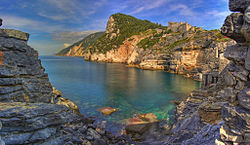
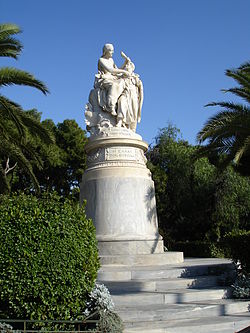
From 1821 to 1822, he finished Cantos 6–12 of Don Juan at Pisa, and in the same year he joined with Leigh Hunt and Percy Bysshe Shelley in starting a short-lived newspaper, The Liberal, in the first number of which appeared The Vision of Judgment. For the first time since his arrival in Italy, Byron found himself tempted to give dinner parties; his guests included the Shelleys, Edward Ellerker Williams, Thomas Medwin, John Taaffe and Edward John Trelawney; and "never", as Shelley said, "did he display himself to more advantage than on these occasions; being at once polite and cordial, full of social hilarity and the most perfect good humour; never diverging into ungraceful merriment, and yet keeping up the spirit of liveliness throughout the evening."
Shelley and Williams rented a house on the coast and had a schooner built. Byron decided to have his own yacht, and engaged Trelawny's friend, Captain Daniel Roberts, to design and construct the boat. Named the Bolivar, it was later sold to Charles John Gardiner, 1st Earl of Blessington, and Marguerite, Countess of Blessington, when Byron left for Greece in 1823.
Byron attended the funeral of Shelley, which was orchestrated by Trelawny after Williams and Shelley drowned in a boating accident on 8 July 1822. His last Italian home was Genoa, where he was still accompanied by the Countess Guiccioli, and the Blessingtons, providing the material for Lady Blessington's work: Conversations with Lord Byron, an important text in the reception of Byron in the period immediately after his death.
Greece
Byron was living in Genoa when, in 1823, while growing bored with his life there, he accepted overtures for his support from representatives of the movement for Greek independence from the Ottoman Empire. With the assistance of his banker and Captain Roberts, Byron chartered the Brig Hercules to take him to Greece. On 16 July, Byron left Genoa arriving at Kefalonia in the Ionian Islands on 4 August. His voyage is covered in detail in Sailing with Byron from Genoa to Cephalonia.
There is a coincidence in Byron's chartering the Hercules. The vessel was launched only a few miles south of Seaham Hall, where in 1815 Byron married Annabella Milbanke. Between 1815 and 1823 the vessel was in service between England and Canada. Suddenly in 1823, the ship's Captain decided to sail to Genoa and offer the Hercules for charter.
After taking Byron to Greece, the ship returned to England, never again to venture into the Mediterranean. "The Hercules was age 37 when on 21 September 1852, her life ended when she went aground near Hartlepool, only 25 miles south of Sunderland, where in 1815, her keel was laid; Byron's keel was laid nine months before his official birth date, 22 January 1788; therefore in ship-years, he was age 37, when he died in Missolonghi."
Byron spent £4000 of his own money to refit the Greek fleet, then sailed for Missolonghi in western Greece, arriving on 29 December, to join Alexandros Mavrokordatos, a Greek politician with military power. During this time, Byron pursued his Greek page, Lukas Chalandritsanos, but the affections went unrequited. When the famous Danish sculptor Bertel Thorvaldsen heard about Byron's heroics in Greece, he voluntarily resculpted his earlier bust of Byron in Greek marble.
Death (1824)
Mavrokordatos and Byron planned to attack the Turkish-held fortress of Lepanto, at the mouth of the Gulf of Corinth. Byron employed a fire-master to prepare artillery and took part of the rebel army under his own command, despite his lack of military experience, but before the expedition could sail, on 15 February 1824, he fell ill, and the usual remedy of bloodletting weakened him further. He made a partial recovery, but in early April he caught a violent cold which therapeutic bleeding, insisted on by his doctors, aggravated. It is suspected this treatment, carried out with unsterilised medical instrumentation, may have caused him to develop sepsis. He developed a violent fever, and died on 19 April.
His physician at the time, Julius van Millingen, son of Dutch-English archaeologist James Millingen, was unable to prevent his death. It has been said that if Byron had lived and had gone on to defeat the Ottomans, he might have been declared King of Greece. However, contemporary scholars have found such an outcome unlikely.
Post mortem
Alfred, Lord Tennyson would later recall the shocked reaction in Britain when word was received of Byron's death. The Greeks mourned Lord Byron deeply, and he became a hero. The national poet of Greece, Dionysios Solomos, wrote a poem about the unexpected loss, named To the Death of Lord Byron. Βύρων ("Vyron"), the Greek form of "Byron", continues in popularity as a masculine name in Greece, and a suburb of Athens is called Vyronas in his honour.
Byron's body was embalmed, but the Greeks wanted some part of their hero to stay with them. According to some sources, his heart remained at Missolonghi. His other remains were sent to England for burial in Westminster Abbey, but the Abbey refused for reason of "questionable morality". Huge crowds viewed his body as he lay in state for two days in London. He is buried at the Church of St. Mary Magdalene in Hucknall, Nottinghamshire.
At her request, Ada Lovelace, the child he never knew, was buried next to him. In later years, the Abbey allowed a duplicate of a marble slab given by the King of Greece, which is laid directly above Byron's grave. Byron's friends raised the sum of 1,000 pounds to commission a statue of the writer; Thorvaldsen offered to sculpt it for that amount. However, for ten years after the statue was completed in 1834, most British institutions turned it down, and it remained in storage. The statue was refused by the British Museum, St. Paul's Cathedral, Westminster Abbey and the National Gallery. Trinity College, Cambridge, finally placed the statue of Byron in its library.
In 1969, 145 years after Byron's death, a memorial to him was finally placed in Westminster Abbey. The memorial had been lobbied for since 1907; The New York Times wrote, "People are beginning to ask whether this ignoring of Byron is not a thing of which England should be ashamed ... a bust or a tablet might be put in the Poets' Corner and England be relieved of ingratitude toward one of her really great sons."
Robert Ripley had drawn a picture of Boatswain's grave with the caption "Lord Byron's dog has a magnificent tomb while Lord Byron himself has none". This came as a shock to the English, particularly schoolchildren, who, Ripley said, raised funds of their own accord to provide the poet with a suitable memorial. (Source: Ripley's Believe It or Not!, 3rd Series, 1950; p. xvi.)
On a very central area of Athens, Greece, outside the National Garden, is a statue depicting Greece in the form of a woman crowning Byron. The statue was made by the French Henri-Michel Chapu and Alexandre Falguière.
Upon his death, the barony passed to Byron's cousin George Anson Byron, a career naval officer.
Poetic works
Byron wrote prolifically. In 1832 his publisher, John Murray, released the complete works in 14 duodecimo volumes, including a life by Thomas Moore. Subsequent editions were released in 17 volumes, first published a year later, in 1833.
Don Juan
Byron's magnum opus, Don Juan, a poem spanning 17 cantos, ranks as one of the most important long poems published in England since John Milton's Paradise Lost. The masterpiece, often called the epic of its time, has roots deep in literary tradition and, although regarded by early Victorians as somewhat shocking, equally involves itself with its own contemporary world at all levels — social, political, literary and ideological.
Byron published the first two cantos anonymously in 1819 after disputes with his regular publisher over the shocking nature of the poetry; by this time, he had been a famous poet for seven years, and when he self-published the beginning cantos, they were well-received in some quarters. It was then released volume by volume through his regular publishing house. By 1822, cautious acceptance by the public had turned to outrage, and Byron's publisher refused to continue to publish the works. In Canto III of Don Juan, Byron expresses his detestation for poets such as William Wordsworth and Samuel Taylor Coleridge.
Byronic hero
The figure of the Byronic hero pervades much of his work, and Byron himself is considered to epitomise many of the characteristics of this literary figure. Scholars have traced the literary history of the Byronic hero from John Milton, and many authors and artists of the Romantic movement show Byron's influence during the 19th century and beyond, including Charlotte and Emily Brontë.
The Byronic hero presents an idealised, but flawed character whose attributes include: great talent; great passion; a distaste for society and social institutions; a lack of respect for rank and privilege (although possessing both); being thwarted in love by social constraint or death; rebellion; exile; an unsavory secret past; arrogance; overconfidence or lack of foresight; and, ultimately, a self-destructive manner. These types of characters have since become ubiquitous in literature and politics.
Parthenon marbles
Byron was a bitter opponent of Lord Elgin's removal of the Parthenon marbles from Greece, and "reacted with fury" when Elgin's agent gave him a tour of the Parthenon, during which he saw the missing friezes and metopes. He penned a poem, The Curse of Minerva, to denounce Elgin's actions.
Sea and swimming
He enjoyed adventure, especially relating to the sea.
The first recorded notable example of open water swimming took place on 3 May 1810 when Lord Byron swam from Europe to Asia across the Hellespont Strait. This is often seen as the birth of the sport and pastime and to commemorate it, the event is recreated every year as an open water swimming event.
Celebrity
Byron is considered to be the first modern-style celebrity. His image as the personification of the Byronic hero fascinated the public, and his wife Annabella coined the term "Byromania" to refer to the commotion surrounding him. His self-awareness and personal promotion are seen as a beginning to what would become the modern rock star; he would instruct artists painting portraits of him not to paint him with pen or book in hand, but as a "man of action." While Byron first welcomed fame, he later turned from it by going into voluntary exile from Britain.
Fondness for animals
Byron had a great love of animals, most notably for a Newfoundland dog named Boatswain. When the animal contracted rabies, Byron nursed him, albeit unsuccessfully, without any thought or fear of becoming bitten and infected.
Although deep in debt at the time, Byron commissioned an impressive marble funerary monument for Boatswain at Newstead Abbey, larger than his own, and the only building work which he ever carried out on his estate. In his 1811 will, Byron requested that he be buried with him. The 26-verse poem Epitaph to a Dog has become one of his best-known works, but a draft of an 1830 letter by Hobhouse shows him to be the author, and that Byron decided to use Hobhouse's lengthy epitaph instead of his own, which read: "To mark a friend's remains these stones arise/I never knew but one — and here he lies."
Byron also kept a tame bear while he was a student at Trinity, out of resentment for rules forbidding pet dogs like his beloved Boatswain. There being no mention of bears in their statutes, the college authorities had no legal basis for complaining: Byron even suggested that he would apply for a college fellowship for the bear.
During his lifetime, in addition to numerous dogs and horses, Byron kept a fox, four monkeys, a parrot, five cats, an eagle, a crow, a crocodile, a falcon, five peacocks, two guinea hens, an Egyptian crane, a badger, three geese, a heron and a goat with a broken leg. Except for the horses, they all resided indoors at his homes in England, Switzerland, Italy and Greece.
Lasting influence
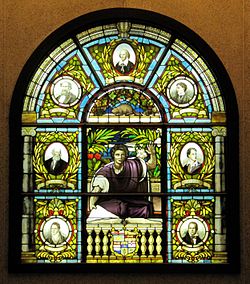
The re-founding of the Byron Society in 1971 reflects the fascination that many people have for Byron and his work. This society has become very active, publishing an annual journal. Today 36 Byron Societies function throughout the world, and an International Conference takes place annually.
Byron exercised a marked influence on Continental literature and art, and his reputation as a poet is higher in many European countries than in Britain or America, although not as high as in his time, when he was widely thought to be the greatest poet in the world. Byron has inspired works by Franz Liszt, Hector Berlioz, Pyotr Ilyich Tchaikovsky, and Giuseppe Verdi.
Depictions in fiction and film
Byron first appeared as a thinly disguised fictional character in his ex-love Lady Caroline Lamb's book Glenarvon, published in 1816.
The archetypal vampire character, notably Bram Stoker's Dracula, is based on Byron. The gothic ideal of a decadent, pale and aristocratic individual who enamors himself to whomever he meets, but who is perceived to have a dark and dangerous inner self is a literary form derived from characteristations of Byron. The image of a vampire portrayed as an aristocrat was created by John William Polidori in The Vampyre, during the summer of 1816 which he spent in the company of Byron. The titled Count Dracula is a reprise of this character.
Byron was the subject of a 1908 play, Byron, by Alicia Ramsey, and its 1922 film adaptation A Prince of Lovers, in which he was played by Howard Gaye.
Byron is the main character of the film Byron, by the Greek filmmaker Nikos Koundouros.
Byron's spirit is one of the title characters of the Ghosts of Albion books by Amber Benson and Christopher Golden. John Crowley's book Lord Byron's Novel: The Evening Land (2005) involves the rediscovery of a lost manuscript by Lord Byron, as does Frederic Prokosch's The Missolonghi Manuscript (1968).
Byron appears as a character in Tim Powers's time travel/alternative history novels The Stress of Her Regard (1989) and The Anubis Gates (1983), Walter Jon Williams's fantasy novella Wall, Stone Craft (1994), and also in Susanna Clarke's alternative history Jonathan Strange & Mr Norrell (2004).
Byron appears as an immortal, still living in modern times, in the television show Highlander: The Series in the fifth season episode The Modern Prometheus, living as a decadent rock star.
Tom Holland, in his 1995 novel The Vampyre: Being the True Pilgrimage of George Gordon, Sixth Lord Byron, romantically describes how Lord Byron became a vampire during his first visit to Greece — a fictional transformation that explains much of his subsequent behaviour towards family and friends, and finds support in quotes from Byron poems and the diaries of John Cam Hobhouse. It is written as though Byron is retelling part of his life to his great great-great-great-granddaughter. He describes travelling in Greece, Italy, Switzerland, meeting Percy Bysshe Shelley, Shelley's death, and many other events in life around that time. Byron as vampire character returns in the 1996 sequel Supping with Panthers.
Byron, Percy and Mary Shelley are portrayed in Roger Corman's final film Frankenstein Unbound, where the time traveller Dr. Buchanan (played by John Hurt) meets them as well as Victor von Frankenstein (played by Raúl Juliá).
The Black Drama by Manly Wade Wellman, originally published in Weird Tales, involves the rediscovery and production of a lost play by Byron (from which Polidori's The Vampyre was plagiarised) by a man who purports to be a descendant of the poet.
Tom Stoppard's play Arcadia revolves around a modern researcher's attempts to find out what made Byron leave the country, while Howard Brenton's play Bloody Poetry features Byron, in addition to Polidori, the Shelleys and Claire Clairmont.
Television portrayals include a 2003 BBC drama on Byron's life, an appearance in the 2006 BBC drama, Beau Brummell: This Charming Man, and minor appearances in Highlander: The Series (as well as the Shelleys), Blackadder the Third, episode 60 ( Darkling) of Star Trek: Voyager, and was also parodied in the animated sketch series, Monkey Dust.
He makes an appearance in the alternative history novel The Difference Engine by William Gibson and Bruce Sterling. In a Britain powered by the massive, steam-driven, mechanical computers invented by Charles Babbage, he is leader of the Industrial Radical Party, eventually becoming Prime Minister.
The events featuring the Shelleys' and Byron's relationship at the house beside Lake Geneva in 1816 have been fictionalised in film at least three times.
- A 1986 British production, Gothic, directed by Ken Russell, and starring Gabriel Byrne as Byron.
- A 1988 Spanish production, Rowing with the wind aka (Remando al viento), starring Hugh Grant as Byron.
- A 1988 U.S.A. production Haunted Summer. Adapted by Lewis John Carlino from the speculative novel by Anne Edwards, starring Philip Anglim as Lord Byron.
The brief prologue to Bride of Frankenstein includes Gavin Gordon as Byron, begging Mary Shelley to tell the rest of her Frankenstein story.
Novelist Benjamin Markovits produced a trilogy about the life of Byron. Imposture (2007) looked at the poet from the point of view of his friend and doctor, John Polidori. A Quiet Adjustment (2008), is an account of Byron's marriage that is more sympathetic to his wife, Annabella. Childish Loves(2011) is a reimagining of Byron's lost memoirs, dealing with questions about his childhood and sexual awakening.
Byron is portrayed as an immortal in the book, Divine Fire, by Melanie Jackson.
In the comic thriller, Edward Trencom's Nose by Giles Milton, several of Edward's ancestors are poisoned, along with Byron.
In The Grim Adventures of Billy & Mandy episode "Ecto Cooler" (2005), the episode opens with a quote from Don Juan. Byron's ghost appears to instruct Billy on how to be cool.
In the novel The History of Lucy's Love Life in Ten and a Half Chapters, Lucy Lyons uses a time machine to visit 1813 and meet her idol, Byron.
Byron is depicted in Tennessee William's play Camino Real.
Byron's life is the subject of the 2003 made for television movie Byron (2003 BBC Drama) starring Jonny Lee Miller.
Byron is depicted as the villain/antagonist in the novel Jane Bites Back written by Michael Thomas Ford, published by Ballantine Books, 2010. A novel based on the premise that Jane Austen (and Lord Byron) are Vampires living in the modern day literary world.
The play A Year Without A Summer by Brad C. Hodson is about Byron, Polidori, the Shelleys, and Claire Clairmont and the famous summer of 1816 at the Villa Diodati. As opposed to other works dealing with the same period, the play is more a biopic dealing with Byron's divorce and exile from England, than with the Shelleys' lives.
Lawrence Durrell wrote a poem called Byron as a lyrical soliloquy; it was first published in 1944.
Susanna Roxman's Allegra in her 1996 collection Broken Angels (Dionysia Press, Edinburgh) is a poem about Byron's daughter by Claire Clairmont. In this text, Byron is referred to as "Papa".
Dan Chapman's 2010 vampire novella The Postmodern Malady of Dr. Peter Hudson begins at the time of Lord Byron's death and uses biographical information about him in the construction of its title character. It also directly quotes some of his work.
Stephanie Barron's series of Jane Austen Mysteries has Lord Byron a suspect of murder in the 2010 book, Jane and the Madness of Lord Byron.
He appears in a parallel story line in the novel The Fire by Katherine Neville.
Byron is also a minor character in the ninth novel of L.A. Meyer's Bloody Jack series The Mark of the Golden Dragon.
In the short story "The Writer's Child" by Tad Williams—collected in the short story anthology The Sandman: Book of Dreams edited by Neil Gaiman and Ed Kramer—Byron is depicted as reincarnated as a child's teddy bear. Described as "clubfoot" for having one leg shorter than the other, and called separately, "young lord" and simply "Byron", it is not til late in the story that he's revealed to be paying penalty for some kind of crime involving a woman named, "Ogusta".
He appears as a drug induced apparition to his dying daughter, Ada, in Romulus Linney's two-act play "Childe Byron".
Byron is one of the main characters in David Liss's 2011 novel The Twelfth Enchantment.
In Hex Hall series by Rachel Hawkins, Lord Byron is shown as a Vampire and the head English teacher at Hecate, the school for witches, warlocks, faeries, werewolves etc.
Musical settings of, or music inspired by, poems by Byron
- 1820 – William Crathern: My Boat is On the Shore (1820), a setting for voice and piano of words from the poem To Thomas More written by Byron in 1817
- c. 1820–1860 – Carl Loewe: 24 songs
- 1833 – Gaetano Donizetti: Parisina, opera
- 1834 – Hector Berlioz: Harold en Italie, symphony in four movements for viola and orchestra
- 1835 – Gaetano Donizetti: Marino Faliero, opera
- 1844 – Hector Berlioz: Le Corsaire overture (possibly also inspired by James Fenimore Cooper's Red Rover as the original title is Le Corsaire Rouge)
- 1844 – Giuseppe Verdi: I due Foscari, opera in three acts
- 1848 – Giuseppe Verdi: Il corsaro, opera in three acts
- 1849 – Robert Schumann: Overture and incidental music to Manfred
- 1849–54 – Franz Liszt: Tasso, Lamento e trionfo, symphonic poem
- 1885 – Pyotr Ilyich Tchaikovsky: Manfred Symphony in B minor, Op. 58
- 1896 – Hugo Wolf: Vier Gedichte nach Heine, Shakespeare und Lord Byron for voice and piano: 3. Sonne der Schlummerlosen 4. Keine gleicht von allen Schönen
- 1916 – Pietro Mascagni: Parisina, opera in four acts
- 1934 – Germaine Tailleferre: Two Poems of Lord Byron (1. Sometimes in moments... 2. 'Tis Done I heard it in my dreams... for Voice and Piano (Tailleferre's only setting of English language texts)
- 1942 – Arnold Schoenberg: Ode to Napoleon for reciter, string quartet and piano
- mid-1970s: Arion Quinn: She Walks in Beauty
- 1984 – David Bowie: Music video for Blue Jean and short promotional video for Blue Jean, Jazzin' for Blue Jean features him playing a rock star named Screaming Lord Byron (cf. Screaming Lord Sutch). His attire for the rock star mimics that of Lord Byron's in the portrait by Thomas Phillips.
- 1997 – Solefald: When the Moon is on the Wave
- 2002 – Ariella Uliano: So We'll Go No More A'Roving
- 2002 – Warren Zevon: Lord Byron's Luggage
- 2004 – Leonard Cohen: No More A-Roving
- 2005 – Cockfighter (band): Destruction
- 2006 – Kris Delmhorst: We'll Go No More A-Roving
- 2006 – Cradle Of Filth: The Byronic Man featuring HIM's Ville Valo
- 2008 – ALPHA 60: The rock, the vulture, and the chain
- 2008 – Schiller (band) has a song called "Nacht" with Ben Becker on its album, Sehnsucht (Schiller album), which has video on Youtube. The lyrics are a shortened version of a poem in German called Die Seele that is attributed to Lord Byron. It appears to be a translation of the Byron poem, "When coldness wraps this suffering clay" from the collection, Hebrew Melodies. The Identity of the translator/author of Die Seele is unknown although the text may be from "Lord Byrons Werke In sechs Bänden" translated by Otto Gildemeister, 3rd Volume, Fifth Edition, Berlin 1903 (pages 134–135).
- 2011 – Agustí Charles: Lord Byron. Un estiu sense estiu. Opera en dos actes (Lord Byron. A summer without a summer. Opera in two actes). Libretto in Catalan by Marc Rosich, world premiere at Staatstheater Darmstadt, March 2011.
- 2012 - When We Two Parted set to music
Perth rock band Eleventh He Reaches London are named in reference to the eleventh canto of Don Juan, in which Don Juan arrives in London. Their debut album, The Good Fight for Harmony also featured a track entitled "What Would Don Juan Do?"

